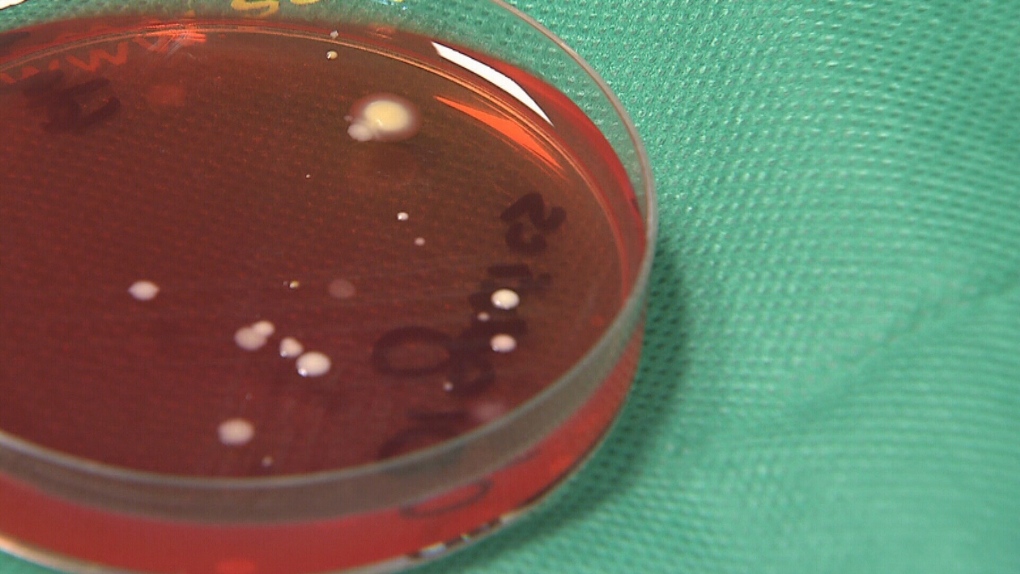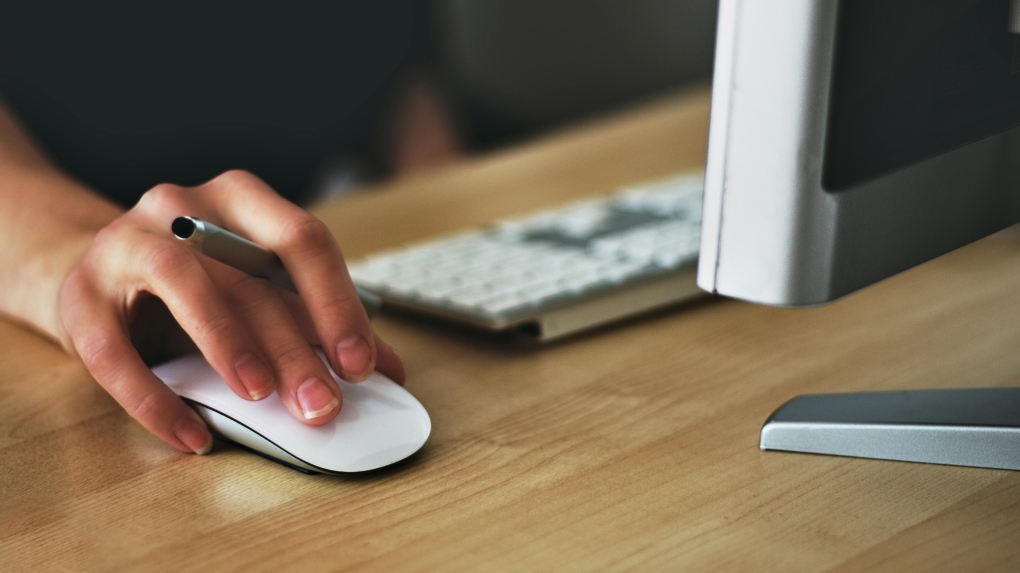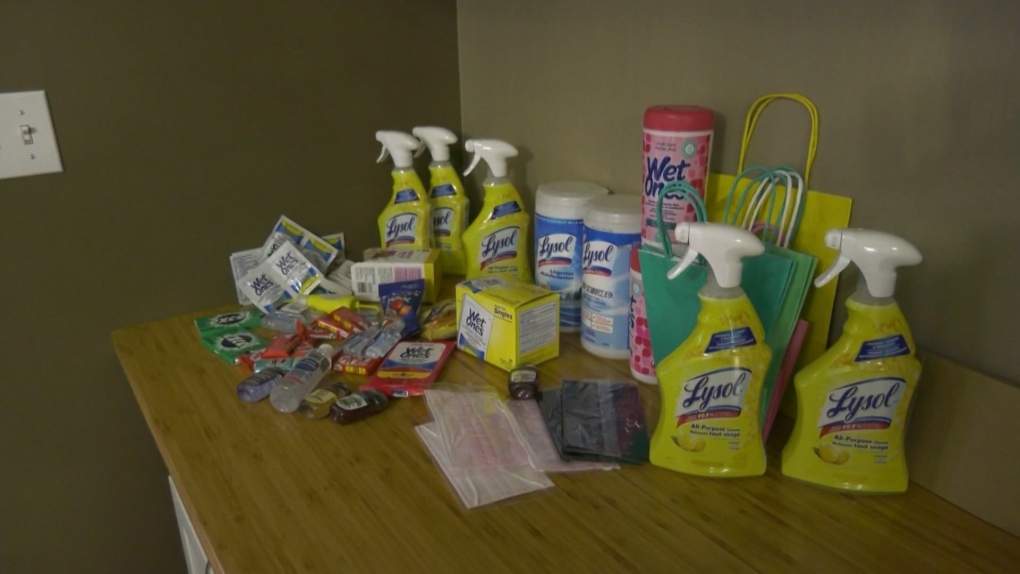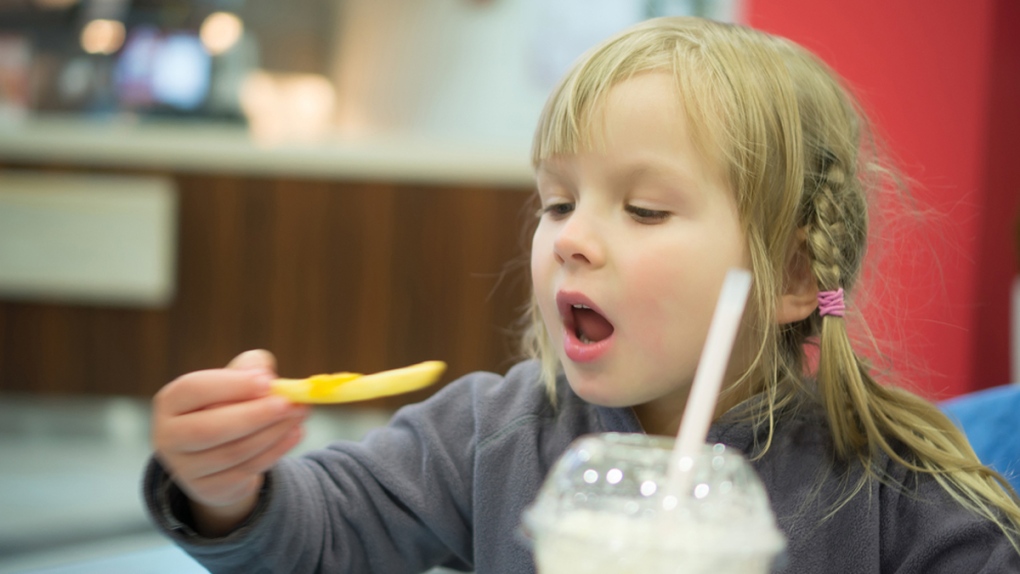Here's the dirt on the germiest items in your day-to-day life
 This colorized 2006 scanning electron microscope image made available by the Centers for Disease Control and Prevention shows E. coli bacteria of the O157:H7 strain that produces a powerful toxin which can cause illness. (CDC/Janice Haney Carr)
This colorized 2006 scanning electron microscope image made available by the Centers for Disease Control and Prevention shows E. coli bacteria of the O157:H7 strain that produces a powerful toxin which can cause illness. (CDC/Janice Haney Carr)
Life gets busy, hectic even. For some, the morning routine is a bustling, but completely necessary task.
Here's the scenario:
You get up, take a shower and dry off with your 'slightly fresh' towel. You brush your teeth, make a hot morning beverage then grab the dish towel and wipe the spill where you accidentally choked on your drink. Make toast, accidentally drop it, then immediately pick it back up from the ground – thankfully, it fell butter-side up.
You eat that, then whip out the cutting board and start chopping veggies for your lunch. After that, you grab the sponge and wash your plate and knife because there's no room in the dishwasher and you're out of dish pods. Out the door with minutes to spare, praying you don't hit that dreaded train.
You're at your office building now. The elevator thankfully opens as you approach as you weave past the other suits to get to your office – press your floor number ... Press it again, since the doors were taking too long and we all know that pressing the button multiple times makes it work faster. The doors shut and you're there ready for the day – but not before a visit to the communal candy dish at reception for that last pick-me-up before you login and dive into work.
Now, let me ask that boogeyman question: how many times did you wash your hands during the morning routine? How many times do you think you should have washed them?
 Washing hands for a minimum of 20 seconds with water and soap is one of the most effective ways to prevent the spread of germs. (Edward Jenner/Pexels)In this hypothetical morning routine, there are 11 instances – excluding all the times you've touched a door handle, cell phone or a sink – where you've been exposed to some of the germiest household and office items.
Washing hands for a minimum of 20 seconds with water and soap is one of the most effective ways to prevent the spread of germs. (Edward Jenner/Pexels)In this hypothetical morning routine, there are 11 instances – excluding all the times you've touched a door handle, cell phone or a sink – where you've been exposed to some of the germiest household and office items.
Gross.
So what can we do to lessen the exposure to germs and microscopic contaminants in our day-to-day lives? Perhaps an informing article on your local news outlet's website?
Let's begin.
Bacteria in the house
Your home – considered to be one of the safest havens from all the external stresses – is filthy.
In 2011, the National Sanitation Foundation (NSF) conducted a study about the dirtiest places in the house. They swabbed many household items for coliform bacteria, a family of bacteria that includes salmonella and E. coli. They've found evidence of those coliforms on:
- More than 75 per cent of dish sponges/rags;
- 45 per cent of kitchen sinks;
- 32 per cent of counter tops; and
- 18 per cent of cutting boards.
 Cultures can be seen growing in a petri dish in this undated file photo. (File)
Cultures can be seen growing in a petri dish in this undated file photo. (File)
So much for those greyish kitchen towels that used to be a pleasant eggshell tone.
Now you might be wondering 'What else is riddled with germs and what can I do about it?'
That's where Jason Tetro comes in. He's a microbiology expert, an educator at the University of Alberta and the writer of two books on our subject matter, The Germ Files and The Germ Code – a professional who knows everything about bacteria and germs. He's also informally known as the Germ Guy.
"The germiest item in the house is the kitchen sponge," Tetro said, doubling up on the CDC's study. "Anything that you're using to … wash your dishes, that's the perfect place where you're going to have all sorts of microbial contamination, and we're talking in the tens of millions for every square centimetre."
 A kitchen sponge cleaning some piled up dished in an undated file photo. (Liliana Drew/Pexels)
A kitchen sponge cleaning some piled up dished in an undated file photo. (Liliana Drew/Pexels)
Tetro said that a sponge's characteristics of being able to retain plenty of water and scrub off contaminants from other dishes can spread its millions of microbes, or very small living things, especially ones that cause disease, onto other surfaces and dishes. It's no wonder it's the grimiest item on the list.
Other perpetrators in the kitchen are coffee-makers or tea kettles, taps and drains in the sink, and cutting boards.
"When it comes to just general germiness and dirtiness, coffee makers and kettles … is definitely something you have to consider. A lot of people think, 'Well, we're just constantly boiling water,'" he said, referring to them as "reservoirs" for growing bacteria. He said they should be added to the regular cleaning list.
 A biodegradable single-serve coffee pod developed at the University of Guelph is seen in a Keurig machine on Friday, Sept. 25, 2015.Cutting boards are also a breeding ground for bacteria if unaccounted for.
A biodegradable single-serve coffee pod developed at the University of Guelph is seen in a Keurig machine on Friday, Sept. 25, 2015.Cutting boards are also a breeding ground for bacteria if unaccounted for.
He said when using a knife on a cutting board, it will leave a tiny groove after the cut. That groove adds more confined spaces where microbes can grow which are difficult to scrub out, especially if we're preparing raw meats. Combining the used sponge with a dirty cutting board, it's likely you are at risk of exposure to salmonella, E. coli, campylobacters, and norovirus.
But according to Tetro, it's not just bacteria we should be concerned about.
"When you're looking at bath mats and things like towels and sinks and that most of the time, you're going to have human microbes, so a lot of skin microbes, you're going to have some fecal coliforms in there."
Towels, sink taps and bath mats get exposed to fecal matter simply because they are close to a toilet. Fecal matter floats in the air of the toilet bowl and when you flush, the circular motion can throw up all the particles in the air and land on other areas in the washroom.
Other guilty offenders around the house include cell phones, tablets, laptops and make-up. All of them could have traces of yeast, mould and fecal coliforms.
Can I see you in my office?
Not likely. We're talking about microscopic matters, after all.
Tetro says when you are actively preventing the spread and infection in an office or at home, it's important to keep note of "high-touch environmental surfaces" – or HITES for short. This means being aware of high-traffic areas where your hands constantly touch something.
"When you're in an office, what you want to do is you want to look at the HITES that are going to lead to greater contamination and greater spread, and those are pretty easy: keyboards, mice, washroom door handles, the sinks (and), obviously, the toilet seat," he said.
 Your computer mouse may be a HITE -- a high-touch environmental surface -- harbouring unwanted germs. (Pexels/Photo by Vojtech Okenka)
Your computer mouse may be a HITE -- a high-touch environmental surface -- harbouring unwanted germs. (Pexels/Photo by Vojtech Okenka)
Our friendly microbiologist recalled a story about him and his colleagues being contacted to investigate an outbreak at a long-term care facility. After running some tests, they discovered the cause.
"I went in there with some colleagues to do some research to find out what was the one thing that was continually contaminated that would have led to everybody getting sick … it turned out it was the elevator button," Tetro said.
It makes perfect sense. How often do you see someone actively scrubbing the buttons of an elevator – and how many people press the buttons on a day-to-day basis?
I assume not so much, and a lot.
There is one more unsuspecting place where 'bring-your-germs-to-work day' is essentially welcomed: the communal candy dish.
Many questions arise when talking about bacteria culture and a candy bowl at work – 'Did you wash your hands when you went to the bathroom?', 'Didn't you have the flu earlier this week?' or ', Did you need to touch all of the M'n'Ms in the candy dish because 'the red ones taste better?'' – all things to consider where bowls of candy are available.
Preventative measures
Cleaning versus disinfecting are often mistaken for one another, Tetro said.
"If you're disinfecting, then you're rendering it safe for human contact. If you're cleaning it, all you're doing is rendering it safe for the human eye in terms of aesthetics."
To add onto this, the Centers for Disease Control and Prevention (CDC) considers three different levels for cleaning:
- Cleaning with soap or detergent decreases the amount of germs on surfaces including virus, bacteria, parasites or fungi;
- Sanitizing reduces the remaining germs on surfaces after cleaning;
- And, disinfecting can kill harmful germs that remain on surfaces after cleaning.
According to the CDC, you should always clean, sanitize, and then disinfect to achieve the best results. For a more in-depth look at how best to clean your home, click the link.
Cleaning
Thanks to our friendly, neighbourhood microbiology expert, we have the simplest solutions to keep your home germ-free.
Take the sponge for example. Those tens of millions of microbes resting easy on the sponge can be dealt with using another everyday household item.
"If you want to disinfect a sponge, the best option for you to do is to get it nice and wet, and then put it in a little container, throw that in the microwave and run it on high for two minutes," he said. Tetro said that experts boiled, bleached, microwaved and ran hot water over the sponges – they all had germs leftover, except the microwaved one.
Remember that cutting board and all of its nasty bacteria-filled crevices? Getting rid of the germs is as easy as running it in the dishwasher.
The Germ Guy said the temperature of the water in the dishwasher reaches between 60 and 70 degrees Celsius. Combine that with the duration of the wash plus the detergent and voilà! Your very own germ-fighting appliance, right at home. Of course, this doesn't handle electronics in the best way, but we have a simple solution for that.
For most handheld items, cleaning them with a disinfectant wipe or rubbing alcohol found at any local drug store or pharmacy is a sure-shot way to handle our unwelcomed friends.
Tetro added that homemade solutions "do a great job in cleaning and degreasing, but they don't do a good job in killing" germs, so it's best to avoid homemade cleaners for the germ-killing cause.
 Cleaning products, wipes, and sanitizer can be seen in this undated file photo. (File)The CDC suggests cleaning hard surfaces like light switches, toys, counters and floors with soap and water or with store-bought cleaning solutions. Soft surfaces like fecal-ridden bath mats, carpets, rugs and drapes should be cleaned with appropriate cleaning products or, when possible, put them in a washing machine on the warmest cycle with detergent and let it dry completely.
Cleaning products, wipes, and sanitizer can be seen in this undated file photo. (File)The CDC suggests cleaning hard surfaces like light switches, toys, counters and floors with soap and water or with store-bought cleaning solutions. Soft surfaces like fecal-ridden bath mats, carpets, rugs and drapes should be cleaned with appropriate cleaning products or, when possible, put them in a washing machine on the warmest cycle with detergent and let it dry completely.
Remember the swirling typhoon of fecal matter in the air caused by flushing the toilet? Cleaning and disinfecting the toilet bowl regularly is your best chance at reducing the spread of fecal particles on surfaces.
It was previously believed that closing the lid before flushing eliminates particles flying about, however a recent study conducted by the American Journal of Infection Control states that it doesn't make a difference.
Germs: Debunked
About bacteria and germs, one myth that favours us: The five-second rule.
You know, when the last Cheeto falls out of the chip bag or that piece of toast drops on the floor.
For those who don't know, it dictates that when some food lands on the floor, it's safe for consumption as long as you pick it up before five seconds of it touching the floor.
So let's get to the bottom of the five-second rule.
"It doesn't exist. It's a total fallacy," Tetro said.
 Researchers found bacteria transfer varied based on the type of food and surface you dropped it on. (Aleph Studio / shutterstock.com)"Literally, as soon as something touches another, there's going to be contact (with germs). I actually did this study in 2007 and what we found was, even if there are two very, very dry surfaces that touch one another, like a floor and a dry piece of toast, there's still going to be some kind of transfer of microbes, not a lot, but it's going to happen immediately. The wetter that it gets, the more transfer that's going to happen."
Researchers found bacteria transfer varied based on the type of food and surface you dropped it on. (Aleph Studio / shutterstock.com)"Literally, as soon as something touches another, there's going to be contact (with germs). I actually did this study in 2007 and what we found was, even if there are two very, very dry surfaces that touch one another, like a floor and a dry piece of toast, there's still going to be some kind of transfer of microbes, not a lot, but it's going to happen immediately. The wetter that it gets, the more transfer that's going to happen."
My heart goes out to all of the parents whose children throw their meal on the floor. At least Tetro said there is a caveat to the rule.
"The best thing to trust is a mother's intuition because they know what areas of the house are clean enough that if something drops on it, you can pick it up and eat it."
Go, moms, go!
Go kill some germs now
It's no doubt that reading this article will likely lead to a desire to rid your household of bacteria and germs. Like I mentioned at the beginning, life gets busy. We don't always have time to fully cleanse our house of the microorganisms that can make us ill.
Tetro explains that we are "made of billions and trillions of cells and about the same amount of microbes" and being in the same proverbial room as them will just take some getting used to – and some knowledge to back it up.
You can learn more about Jason's work on his website.
Knowing how to prevent these germs from spreading and what to avoid at the workplace is more than half the battle.
Just remember to wash your hands.
CTVNews.ca Top Stories

'Hell on earth': Ottawa rapper TwoTiime among Canadians displaced by L.A. fires
Ottawa rapper Khalid Omar, who performs under the name TwoTiime, was forced to evacuate his Calabasas condo as wildfires tore through the Los Angeles area this week, leaving the studio where he records in ruins.
Alberta premier Danielle Smith meets with Trump at impromptu Mar-a-Lago visit
Alberta premier Danielle Smith met with President-elect Donald Trump Saturday at Mar-a-Lago in Florida.
Costco Canada accused of overcharging online shoppers in class-action lawsuit
Perrier Attorneys says Costco charged more for items online than in-store, a practice known as “double ticketing,” which is banned under the Competition Act.
Meet Franklin, the rescued tortoise who spent the last three months in a B.C. fridge
Franklin the tortoise has been in a fridge for the past 15 weeks.
Are there U.S. military bases and American troops in Canada?
The U.S. military has more than 165,000 troops deployed in over 170 countries and territories, including Canada.
'He was a genius': Family remembers man who died waiting for care in Winnipeg ER
The sister of a man who died waiting for care in the emergency department of Winnipeg’s Health Sciences Centre (HSC) is remembering her late brother as an intelligent person with a bold personality
Teen's road test halted by stunt driving charge
A 17-year-old driver failed their road test before it even began after being stopped by police in a community safety zone.
Former PM Chretien says Liberal party must move back to 'radical centre'
As the Liberal party searches for a new leader, former prime minister Jean Chretien says it's time for the party to move back to the "radical centre" to help its electoral fortunes.
Trudeau says Trump's comments on 51st state 'flattering' but a 'non-starter'
Prime Minister Justin Trudeau says talk of Canada becoming the 51st state is a distraction from more pressing threats of U.S tariffs on Canada and their likely impact.
































